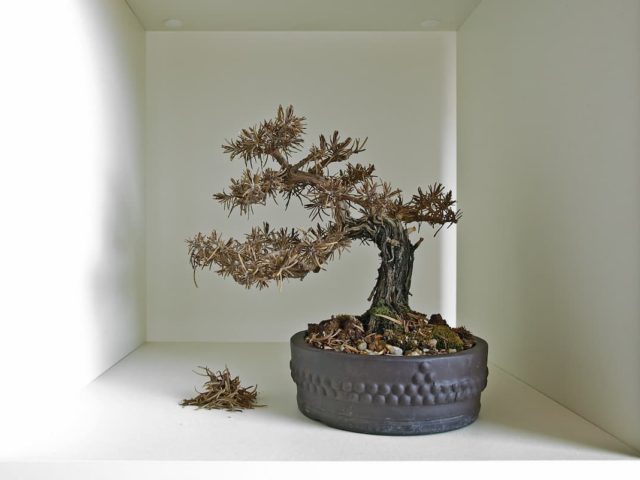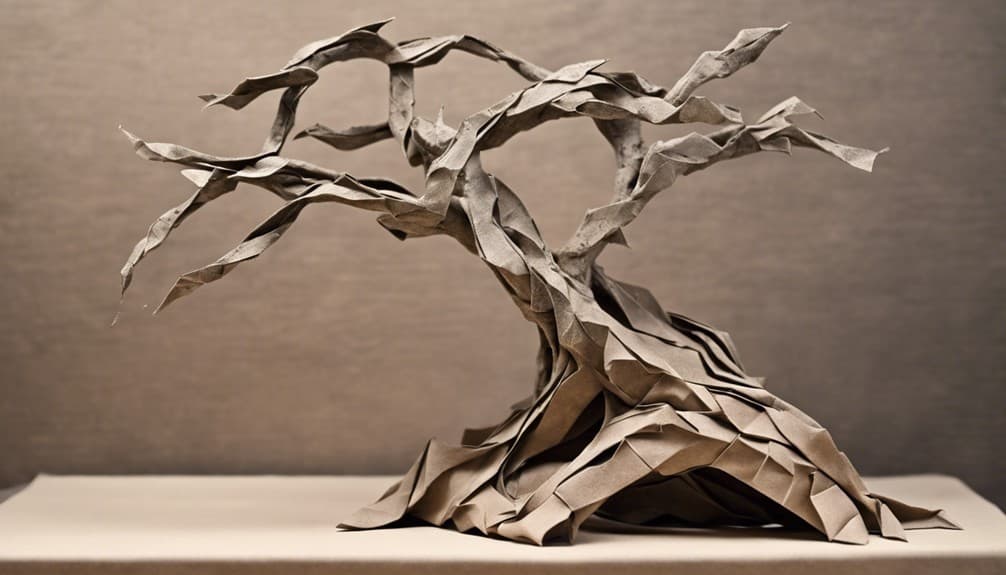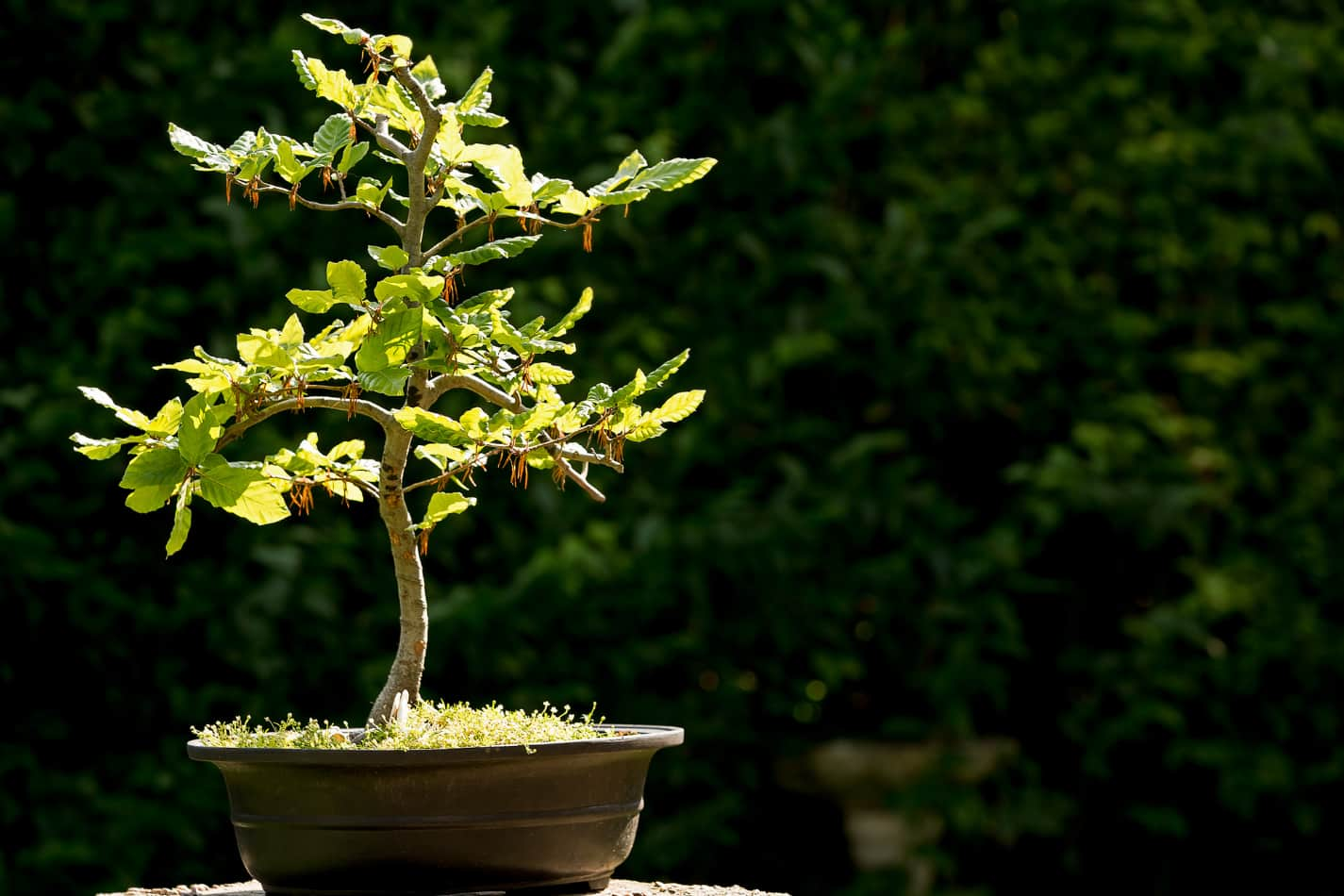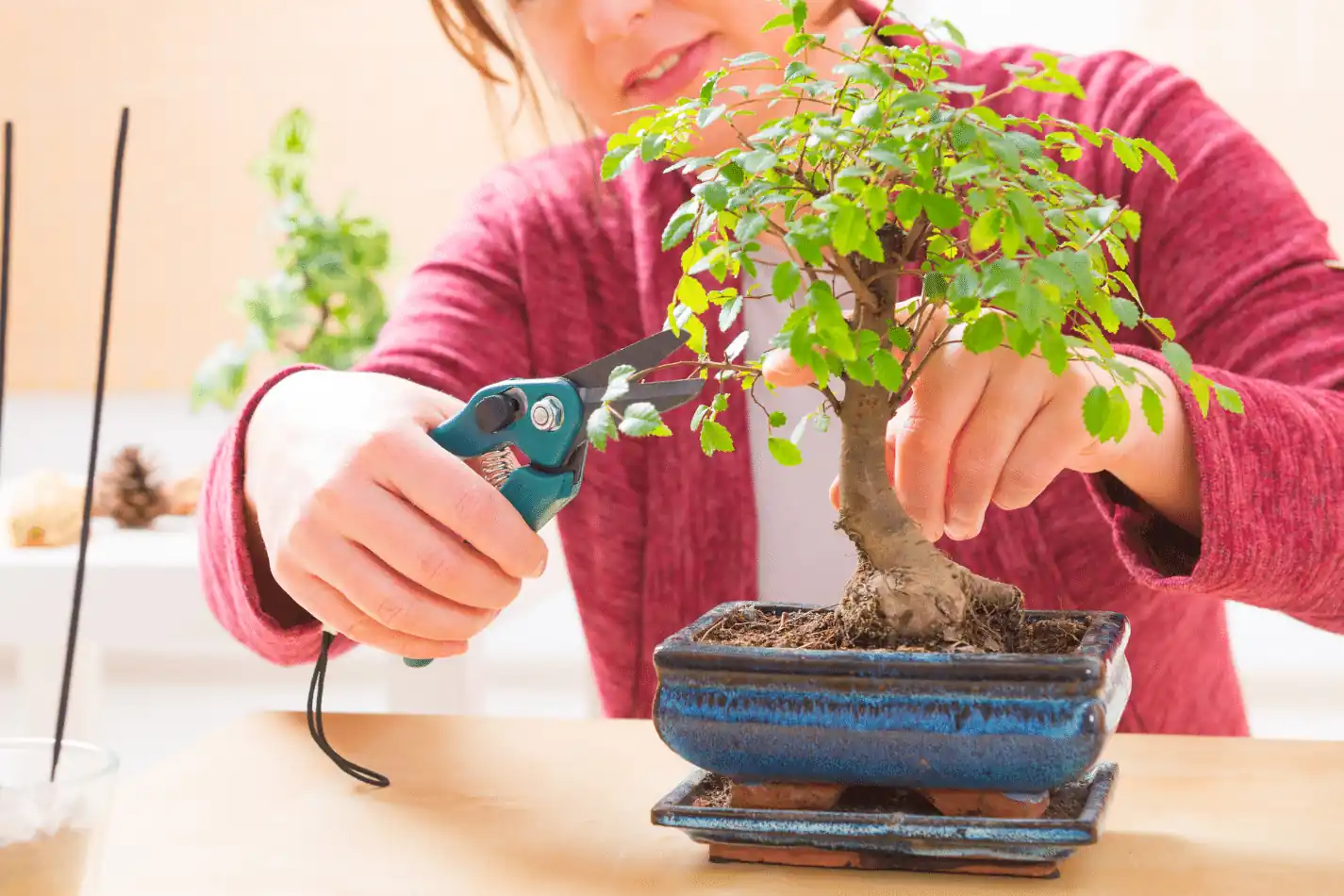You may be surprised to open a gift and find a neatly wrapped bonsai tree, or you simply bought one that looked amazing from your local nursery.
Now that you have the bonsai tree you need to start caring for it in the right way, this is the way that many people start losing their trees, usually because of simple mistakes made by owners.
Knowing the complete basics of taking care of a bonsai tree is important and will save your tree from you.
You need to trim your bonsai every one-to-two-weeks to stop new branches from growing, watering most trees once every two weeks. Bonsai trees need to be wire trained to ensure that everything is growing perfectly while checking the roots at least once a season to ensure proper growth. The beginning years of owning a bonsai tree are about to ensure it is growing in the way that the nursery has suggested.
There are many finer things to know if you are still a beginner, wire training is one of the most confusing things most people hear about when they start in the world of bonsai.
Some of the stranger things that many finds can be in how to pinch the roots, or even how to control new branches once they start growing. We have created a complete guide to bonsai owning that every beginner should get into.Â
How do you take care of a bonsai tree?
When you have your tree on the desk, coffee table, or even in the kitchen window you will soon see it start wilting and looking unhappy.
Or you may be keeping it in the perfect spot, where it quickly starts growing so much faster and larger than you could ever have expected.
If would be amazing if we could find trees that only ever grow to the size of a bonsai, however, they need constant work for this.
Bonsai trees are remarkably complex things to own and varying on the type can outlast most people, some of the most amazing things can be done to make a bonsai unlike anything else on earth.
To understand how to do this you need to learn about the basics of bonsai trees and what will
Take care of roots
In a normal tree you may think about the roots that it has when you want to remove the tree, a root is breaking something, or a storm blew over a surprisingly large tree.
When it comes to bonsai trees this is entirely different, you need to give constant attention to the roots of the trees. Bonsai trees will do most of their growth under the soil, with their roots.
You will need to see how the roots are growing at least once every two years, usually significantly trimming them to ensure there is more space to grow.
After three to four years of your bonsai growing in the same pot, it will no longer be able to grow anymore, this is when you need to remove the bonsai, trim the roots, and then plant it into a larger pot.
Roots are usually the first reason a bonsai dies because people remember to take care of the top but forget about life underground.
Trim the branches
The branches of any bonsai tree will constantly be trying to grow and become a full tree, which is where almost all the work for you will start.
Most beginner bonsai trees will want to grow the whole year, which creates work for you as the owner to constantly be working to remove or trim them.
This can easily become the reason that a bonsai has to either be radically trimmed or planted in a full garden as the branches can grow out of control.
If you see new branches growing out of the bonsai when you don’t want any you need to pinch them off with your fingertips.
Further, you need to trim the already existing branches, forcing them to grow thicker but not specifically larger with more leaves.
The branches that are on your bonsai will need to be bent or trimmed as well, this is the best way to ensure they continue to grow without becoming something that kills your tree through overexertion.
Water correctly
You’ll be tempted to water your bonsai every day, with too many people usually starting to get worried when the tree starts dying and watering even more.
Many of the recommendations and pamphlets that you get will be generic advice, telling you to water regularly, however, this is a mistake as bonsai trees do not need this much water.
Bonsai trees should be watered at most once a week, with some bonsai trees preferring to only be watered once every two to three weeks.
Not only does watering the tree too much cause fungi and other unwanted things to grow on the tree, but it can also cause the soil to harden significantly, which means that the roots can no longer grow in the soil that is now basically a rock.
Timing the seasons
You cannot go in with your shears anytime in the year and start trimming parts of your bonsai tree.
Not only can this significantly scar the tree, but it can also prevent proper growth and even cause the tree to get rotten from the inside out.
People that trim or treat their bonsai trees for things at the wrong time of year quickly kill their bonsais.
During the spring you need to trim your tree and it is also a good time to allow your bonsai to be wire trained, while the summer is a great time to let it grow and expand.
Winter and autumn are the months in which most trees won’t do anything, you can also slow down the watering significantly to only a few times in the season.
This allows the tree to comfortably be in hibernation without any stresses or unfortunate scarring.
Repot Bi-yearly
Repotting every two years is the most complicated thing a beginner bonsai tree owner will do, usually, because you need to mix new soil, clean roots, trim roots, and eventually find a new pot.
All of this can seem daunting if you’ve never had to do it before, or if you’ve seen the ease at which a bonsai master can do this.
Fortunately, you don’t always need to get a new pot for your bonsai, usually, you can achieve a perfect repotting when you trim the roots and replant the bonsai in the same pot.
This is what you should be doing with each pot for at least 4 years while repotting into a new pot should be a process of allowing the roots more space to expand in when they want to.
Wiring properly
Probably the weirdest thing we do to bonsai trees to get them into the shape that we need is wire training the tree.
This is almost literally what it sounds like and involves a long list of complicated things that need to happen to ensure the bonsai does what you need from it.
Many bonsai trees that are wired up wrongly usually end up having a few weak branches that need to be removed when they grow too heavy.
To wire up your bonsai for the first time it is important that you rather start with only the branches, leaving the trunk of the tree for later.
Using thick wire that you can bend with pliers but won’t bend to the tree’s will you need to encourage each branch to go in the directions that you want.
A bonsai will grow into the shape you need over several years, you should be sure that when you are wire training the tree that it does not crack or break.

What type of bonsai tree should I get?
The basics of having a bonsai tree are made significantly easier by the type of tree you have, with some trees being so sensitive and complex that it requires groups of bonsai masters to take care of them.
Fortunately, there are several trees out there that have been identified as easy to take care of, these are the trees that you will usually find for sale at your local nursery.
These are the trees that we recommend that you get, and we know that you might want to get something a lot more impressive.
However, having one of these trees for a year or two allows you to build the required routines and skills without having to sacrifice a tree that could be worth a significant amount.
If these trees die it may be painful, but your wallet won’t always be there crying next to you.
- Ficus: Ficus trees are quite common around the world, with most countries having their variant that grows the best there. This is the reason that most nurseries will have some type of ficus that has been shaped into a bonsai tree. For you, this means that the price is not too high, and you can easily grow the tree as it is hardy and won’t easily be damaged.
- Hawaiian Umbrella: If you’re thinking of a beach with white sands, clear water, and a lot of trees, chances are you’re thinking of some part of Hawaii. The Hawaiian Umbrella is a bit of an odd tree in the world of bonsai, but it is also one of the hardier trees to grow. Looking quite good, the tree can be a bit pricier but will allow you to make mistakes while you are learning the bonsai crafts.
- Serissa: Easily one the smallest, but sun hungry trees in the world of bonsai the Serissa tree is a bit more complex than the average beginner bonsai. However, its small size allows you to place it somewhere with more insight and gives you the chance to learn what not to do. These are indoor trees that require warmth throughout the year.
- Gardenia: An evergreen tree that likes tropical temperaments this is not a tree to keep in any of the northern hemispheres. However, if you are in a warmer climate it will deliver stunning growths and allow you to enjoy a much better-quality tree. Gardenias have amazing pure white flowers and a thick trunk that makes them sturdier than most other bonsai trees.
- Juniper Tree: Possibly one of the most singularly popular bonsai trees in the world, the Juniper Tree has been a mainstay with bonsais since they were first created. Famed for their thin, long trunks that can be trained into a myriad of shapes, the Juniper tree also has fine small leaves that add significant value to its aesthetics. As a bonus, they are amazingly sturdy once fully mature and won’t die as easily as some species.
- Pine tree: Those bonsai that you have seen overhanging their pots, have twisting trunks, or just look majestic. Pine trees are some of the oldest trees in the world, and bonsai made out of Pine trees are easy to take care of and simple to understand for most beginners. In some countries they can be more expensive, however, they make for some amazing additions to your early bonsai collection.
- Cedar: Slightly trickier than other bonsai for beginners to grow, this may not be the first tree you buy but should be among the second ones you are buying. They are simply amazing and look the best when they look almost entirely natural. Unlike other bonsai trees Cedar likes to grow rather straight and unless trimmed will become quite tall before sprouting too many branches.
- Ginseng Ficus: A slightly more sun hungry, water strong bonsai the Ginseng Ficus can look odd if not properly trained. However, this is the perfect tree to test your beginner level skills as it can be quite hardy, with roots that will grow on and through rocks if necessary. The tree should be watered carefully and trimmed with care as it can start growing erratically if left for too long.
How often should you feed a bonsai tree?
Feeding a bonsai is not what you imagine, it is the art of adding fertilizer to the soil that your bonsai is currently growing in.
This is also not the fertilizer you may be throwing onto the plants in your garden, the fertilizer for your bonsai is a special mixture that has the right things needed for your tree.
What this means is that the fertilizer won’t be too acidic and burn the roots of your tree.
You should be remixing the soil with fresh fertilizer at the beginning of the growing season, right after you have checked on the roots or repotted the bonsai.
Once that is done, remove some of the topsoils and add in a mixture of fresh soil and fertilizer every 2 weeks for your bonsai. This will ensure that the tree has all the right nutrients without being burned.
You must remember that you can add too much fertilizer, and this will cause heavy damage to your bonsai. With some fertilizers even having fungi in them, it is best to add it sparingly after the initial mixing.
A tree that needs some more nutrients is easier to treat than one that got burned and is on its last legs before complete death.
How do I know if my tree needs water?
An important thing that you should always remember about bonsai trees is that they are not potted plants. A potted plant will wilt in the morning when not watered right and be back to fully healthy within four to six hours.
Bonsai trees are not like this, they are trees and can take weeks to show symptoms of not being watered enough.
The best and only accurate way to see if your tree needs water is checking on the soil of your bonsai, the soil of a bonsai tree should never be bone dry and cracking.
It should always be soft and slightly moist, if you dig a small hole then there should almost muddy but not wet sand under the surface. It is important to check this as soil that is too hard will only cause damage to the tree.
You mustn’t overwater your tree, this causes just as many problems as under-watering your tree, which is why you should only water every two to three weeks.
Bonsai trees that do need more water will have special classifications and you should be able to easily reach out to other owners to know. The ground that is overly wet only encourages root rot throughout the entire root system.
What should you be checking regularly?

Basic care and maintenance of a bonsai tree is probably the most complicated part of owning any bonsai, seeing as they regularly do weird or new things that owners aren’t prepared for.
Bonsai trees that have reached their maturity are much easier to care for than those that are still active in their juvenile ages.
You should be checking the trunk and the area where the tree meets the ground regularly for fungi and root rot, while constantly checking the leaves for insect bites.
However, there are things you need to check every day, things you check every week, and things that are seasonal or monthly.
What to check each day?
Every day you may need to just take a quick look at your bonsai, checking how they handled the night or the day.
Many bonsai trees will show some signs of stress they had during the day, usually done when someone broke a branch, or a bug started attacking them.
Leaving an insect to eat most of your bonsai for even a day or two can cause permanent scarring to the branches and trunk.
Bonsai owners will regularly be working on removing either worms, eggs, or beetles from the tree. Fortunately, this is something that only takes a few minutes and won’t take up too much of your time.
Checking every week
While checking every day can be taxing there are many seasons in which you can be a bit more relaxed and the tree will either be growing so strongly that it needs little care or when it is in hibernation.
For evergreens, this is a lot more important to check every few weeks than it is for other trees. Doing a few more in-depth checks once a week when you water the tree will ensure that it is growing properly.
You will need to check the soil quality at least once a week and check the growth of anything else in the soil of the bonsai.
Removing smaller plants that you don’t want while encouraging the growth of moss on trees that prefer more humid environments.
Further, you will need to check that the roots aren’t rotting while making sure the tree is still growing healthily.
Checking every month
During growing seasons you may need to check everything once a week, however, there are several things about your bonsai that you can be a bit more relaxed about.
Many owners decide when to check these not specifically on a schedule but rather on what they did to the tree the last time they checked the tree.
The growth of new branches, the root health, the growth in new directions, or removing the buds of new branches, should all be done at least once a month.
Checking on these things during hibernation is how you will know when the seasons are changing and the plants are ready to start growing slower or faster.
Where to keep different types of bonsai trees?
Not all bonsai trees are the same and the bonsai trees that a beginner should try to keep are the ones that love hot weather and sunlight a lot more.
These are the bonsai that you can leave most of the time to grow a bit more on their own. Many owners enjoy letting their bonsai grow more freely, usually when they know the tree is native to their country.
However, not everyone lives in areas where trees are always growing, and many people in deserts or frozen areas like tropical-looking trees that need special treatment.
These are the three types of trees most beginner bonsai owners will have and how to care for them.
Temperate trees
The most popular tree kind for most bonsai are temperate trees, these are the trees you can find growing in most suburbs around the world.
Usually, in areas where there is no snowfall during winter, this is why these trees are so loved by the bonsai community.
These bonsai trees need constant sunlight and can mostly be left just outside your doorstep, where they can get fresh air and constant exposure.
If you live in a colder country you should be keeping the tree inside, but still in an area where it constantly gets sunlight.
Tropical trees
A bit more complicated tropical trees are close to temperate trees with a few added caveats that usually drive them to be inside trees in warmer countries.
It is vital to remember that tropical trees need one thing that they can always find in dense forests that can be hard to simulate in air-conditioned homes.
Tropical trees need constant humidity, where they will rarely dry out even in the hottest parts of the day.
To accomplish this many people build mini greenhouses or place plates of water that they refill throughout the day underneath the tree.
This allows the tree to have all the right levels of humidity, without ever drying out.
Caudiciform Plants
These are desert trees; they will have thick leaves and thicker trunks than most other trees. They are perfect for countries that are a lot hotter throughout the year or areas in the house where humidity would always be a problem.
Because of their hardiness, people love to use them for bonsai trees when they are still learning everything.
Caudiciform trees need a lot of suns, usually enjoying up to 12 hours of sun each day, which is why they should never be kept in countries that are dreary or clouded most of the year.
They prefer being more south from England than actually being in England, allowing owners to also care a bit less because they keep their water significantly longer than a normal tree.
Final Thoughts on How Do You Take Care of a Bonsai Tree for Beginners
Owning a bonsai is a fun and new experience that anyone should attempt, some of the best trees in the world are those that were kept by families for literal generations.
If you follow the basic steps the more complicated tasks will become significantly easier to accomplish once you do get your dream bonsai.
Just be sure you don’t buy a bonsai that was rapidly grown in China and then cut down back to size, these are mass-produced and only live a few years.
If you are just learning about bonsai trees and looking to purchase high quality trees that will likely live longer than you then I would highly suggest checking out Bonsai Boy Trees as they are a long lasting New York business that provides trees for all price ranges!







